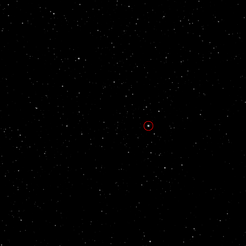Rosetta’s comet returns to slumber
In new images obtained by Rosetta’s scientific imaging system OSIRIS, comet 67P/Churyumov-Gerasimenko shows a decline in activity.
As ESA’s spacecraft Rosetta decelerates in preparation of its rendezvous with comet 67P/Churyumov-Gerasimenko in early August, the onboard scientific imaging system OSIRIS reveals a surprise: after the first evidence of activity at the end of April, the comet is currently at rest again. New images no longer show signs of an extended dust coma surrounding the comet’s nucleus.

Less than half the distance between Earth and Moon still separate Rosetta from its destination. “67P is now almost within our reach – and teaching us to expect the unexpected”, says OSIRIS Principal Investigator Holger Sierks from the Max Planck Institute for Solar System Research (MPS) in Germany. The distinct dust coma that enveloped the comet in images dating from the end of April is no longer evident. “After 67P’s onset of activity, our images are currently showing a comet at rest”, Sierks adds. While it is not uncommon for comets to display varying levels of activity, it is the first time that scientists witness the onset of dust production continuously and from such a close distance.
Upcoming images will offer even more information, as the comet is quickly covering more space in OSIRIS’ field of view. Currently, 67P scales to one pixel – and counting. “It will still take a few weeks before we can discern a detailed shape”, OSIRIS Project Manager Carsten Güttler from the MPS anticipates. “But we are now no longer restricted to studying the brightness of the nucleus.”
Rosetta is an ESA mission with contributions from its member states and NASA. Rosetta's Philae lander is provided by a consortium led by DLR, MPS, CNES and ASI. Rosetta will be the first mission in history to rendezvous with a comet, escort it as it orbits the Sun, and deploy a lander to its surface.
The scientific imaging system OSIRIS was built by a consortium led by the Max Planck Institute for Solar System Research (Germany) in collaboration with CISAS, University of Padova (Italy), the Laboratoire d'Astrophysique de Marseille (France), the Instituto de Astrofísica de Andalucia, CSIC (Spain), the Scientific Support Office
of the European Space Agency (The Netherlands), the Instituto Nacional de Técnica Aeroespacial (Spain), the Universidad Politéchnica de Madrid (Spain), the Department of Physics and Astronomy of Uppsala University (Sweden), and the Institute of Computer and Network Engineering of the TU Braunschweig (Germany). OSIRIS was financially supported by the national funding agencies of Germany (DLR), France (CNES), Italy (ASI), Spain (MEC), and Sweden (SNSB) and the ESA Technical Directorate.
